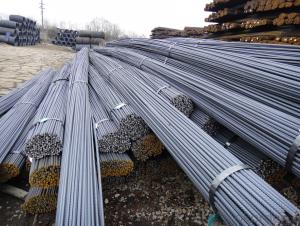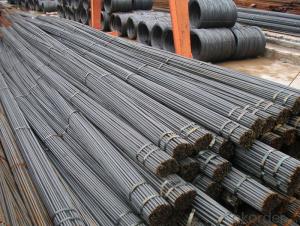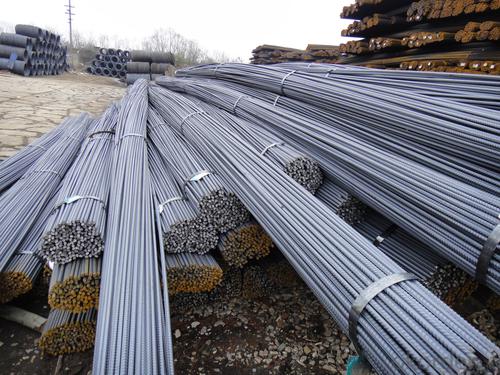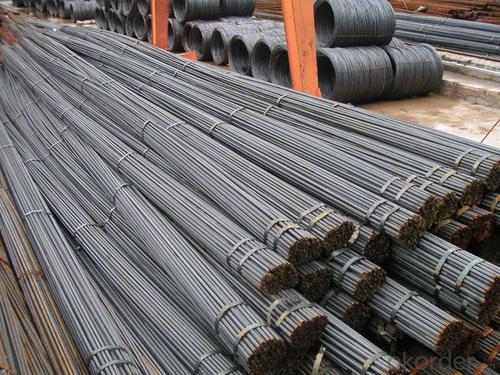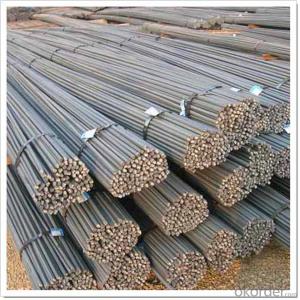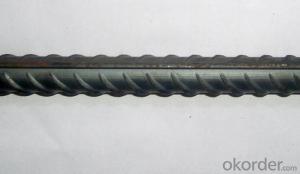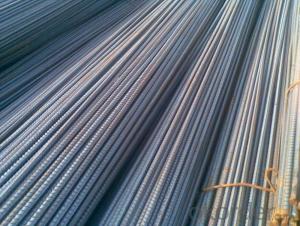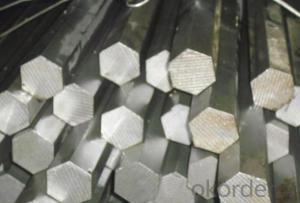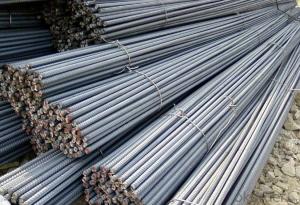Hot Rolled Carbon Steel Deformed Bar 32mm with High Quality
- Loading Port:
- China Main Port
- Payment Terms:
- TT or LC
- Min Order Qty:
- 25 m.t.
- Supply Capability:
- 20000 m.t./month
OKorder Service Pledge
OKorder Financial Service
You Might Also Like
Product Description:
OKorder is offering Hot Rolled Carbon Steel Deformed Bar 32mm with High Quality at great prices with worldwide shipping. Our supplier is a world-class manufacturer of steel, with our products utilized the world over. OKorder annually supplies products to European, North American and Asian markets. We provide quotations within 24 hours of receiving an inquiry and guarantee competitive prices.
Product Applications:
Hot Rolled Carbon Steel Deformed Bar 32mm with High Quality is widely used in buildings, bridges, roads and other engineering construction. Big to highways, railways, bridges, culverts, tunnels, public facilities such as flood control, dam, small to housing construction, beam, column, wall and the foundation of the plate, deformed bar is an integral structure material. With the development of world economy and the vigorous development of infrastructure construction, real estate, the demand for deformed bar will be larger and larger..
Product Advantages:
OKorder's Hot Rolled Carbon Steel Deformed Bar 32mm with High Quality are durable, strong.packed and suitable for construction
Main Product Features:
· Premium quality
· Prompt delivery & seaworthy packing (30 days after receiving deposit)
· Can be recycled and reused
· Mill test certification
· Professional Service
· Competitive pricing
Product Specifications:
Manufacture: Hot rolled
Grade: HRB335 HRB400 BS4449 Grade460 ASTM Grade40 Grade60
Certificates: ISO, SGS, BV, CIQ
Length:6m 8m 9m 12m
Packaging: Export packing, packed by coil
FAQ:
Q1: Why buy Materials & Equipment from OKorder.com?
A1: All products offered byOKorder.com are carefully selected from China's most reliable manufacturing enterprises. Through its ISO certifications, OKorder.com adheres to the highest standards and a commitment to supply chain safety and customer satisfaction.
Q2: How do we guarantee the quality of our products?
A2: We have established an advanced quality management system which conducts strict quality tests at every step, from raw materials to the final product. At the same time, we provide extensive follow-up service assurances as required.
Q3: How soon can we receive the product after purchase?
A3: Within three days of placing an order, we will begin production. The specific shipping date is dependent upon international and government factors, but is typically 7 to 10 workdays.
Q4: How many tons per bundle?
A4: Around 2-3tons
Q5: How to avoid the rust after deliver the goods to the loading port?
A5: We will keep the goods at the port covered with water-proof material
Q6: What is the chemical composition and physical properties of HRB400?
A6:
Grade | Technical data of the original chemical composition (%) | ||||||
C | Mn | Si | S | P | V | ||
HRB400 | ≤0.25 | ≤1.60 | ≤0.80 | ≤0.045 | ≤0.045 | 0.04-0.12 | |
Physical capability | |||||||
Yield Strength (N/cm²) | Tensile Strength (N/cm²) | Elongation (%) | |||||
≥400 | ≥570 | ≥14 | |||||
Q7:What is chemical composition and physical properties of 500B?
A7:
BS4449 500B | Chemical Composition(%) | ||||
C | Mn | Si | S | P | |
≤0.24 | ≤0.45 | ≤0.16 | ≤0.05 | ≤0.31 | |
Physical capability | |||||
Yield Strength(N/cm²) | Tensile Strength(N/cm²) | Elongation (%) | |||
≥650 | ≥500 | 19 | |||
Q8: What is the chemical composition and physical properties of HRB335?
A8:
HRB335 | Chemical Composition(%) | ||||
C | Mn | Si | S | P | |
≤0.25 | ≤1.60 | ≤0.80 | ≤0.045 | ≤0.045 | |
Physical capability | |||||
Yield Strength(N/cm²) | Tensile Strength(N/cm²) | Elongation (%) | |||
≥335 | ≥490 | ≥16 | |||
Images:
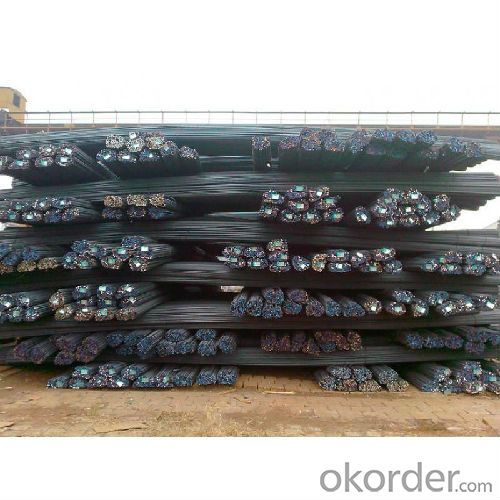
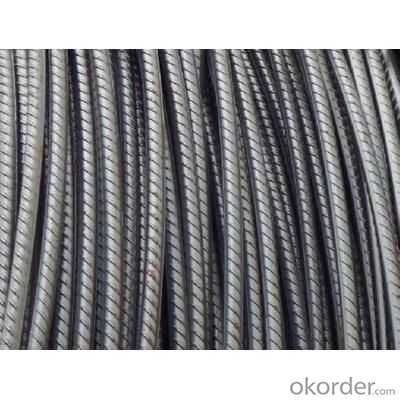
- Q: Can steel rebars be used in composite construction systems?
- Indeed, steel rebars can be employed within composite construction systems. Composite construction denotes the merging of various materials, typically concrete and steel, to generate a sturdier and more effective structure. Steel rebars are frequently utilized as reinforcement in concrete structures, delivering supplementary strength and longevity. Within a composite construction system, steel rebars are integrated into the concrete, establishing a connection between the two materials. This amalgamation permits the utilization of concrete's compressive strength and steel's tensile strength, resulting in a remarkably efficient and resilient structure. The utilization of steel rebars in composite construction systems provides numerous advantages. Primarily, it bolsters the structural integrity of the construction by amplifying its load-bearing capacity and resistance to external forces such as earthquakes or heavy loads. Additionally, steel rebars assist in managing cracking and enhancing the overall durability of the structure. Moreover, steel rebars offer flexibility in design and construction. They can be easily molded and positioned in accordance with the specific requirements of the structure, enabling intricate and complex designs. Furthermore, steel rebars can be prefabricated off-site, streamlining the construction process and saving time. In conclusion, steel rebars are an essential element of composite construction systems. Their incorporation in conjunction with concrete offers numerous benefits, including heightened strength, durability, and flexibility.
- Q: What is the process of bending steel rebars?
- The process of bending steel rebars involves using specialized tools, such as rebar benders or hydraulic benders, to shape the steel bars into the desired angle or curve. This is typically done by placing the rebar into the bending machine, adjusting the angle or radius, and applying pressure to gradually bend the steel to the desired shape. The bending process requires precision, as it needs to meet the specific design requirements and specifications for construction projects.
- Q: What are the factors that affect the durability of steel rebars in concrete?
- There are several factors that can affect the durability of steel rebars in concrete. These include the quality of the steel used, the level of corrosion protection provided, the design and construction practices, the exposure conditions (such as moisture and temperature), and the presence of aggressive chemicals in the surrounding environment.
- Q: How do steel rebars contribute to the ductility of reinforced concrete structures?
- Steel rebars contribute to the ductility of reinforced concrete structures by providing reinforcement and increasing tensile strength. The rebars act as a skeleton within the concrete, absorbing and distributing external forces such as tension and compression. This reinforcement prevents the concrete from cracking or failing under stress, allowing the structure to withstand greater loads and deform without collapsing, thus enhancing its overall ductility.
- Q: What are the main properties of steel rebars?
- Steel rebars, also referred to as reinforcing bars, play a vital role in reinforced concrete structures due to their numerous advantageous characteristics. Firstly, steel rebars possess a high tensile strength, which enables them to withstand substantial pulling forces and effectively reinforce concrete to prevent cracking and structural failure. Secondly, steel rebars exhibit exceptional ductility, meaning they can deform under stress without fracturing. This flexibility allows them to absorb energy during seismic events or extreme loads, enhancing the overall performance and resilience of the reinforced concrete. Moreover, steel rebars are manufactured with a protective layer, such as epoxy or galvanized coating, to ensure corrosion resistance. This property is crucial as exposure to moisture, chloride ions, and other corrosive elements can significantly weaken the rebars and compromise the structural integrity. In addition, steel rebars can be easily welded together, facilitating efficient and effective construction. This feature enables the rebars to be connected seamlessly, forming a continuous and robust reinforcement network that enhances the overall strength and stability of the concrete structure. Furthermore, steel rebars possess thermal compatibility with concrete, meaning they have similar expansion and contraction properties. This characteristic minimizes the risk of cracking or structural damage caused by temperature changes, ensuring the long-term durability and stability of reinforced concrete structures. Lastly, steel rebars are widely available and relatively cost-effective compared to alternative reinforcing materials. This affordability, combined with their exceptional mechanical properties, makes them a popular choice for structural reinforcement in various construction projects. In conclusion, steel rebars offer high tensile strength, ductility, corrosion resistance, weldability, thermal compatibility, and cost-effectiveness. These properties are indispensable for providing structural strength and durability to reinforced concrete structures.
- Q: How do steel rebars improve the structural integrity of a building?
- Steel rebars improve the structural integrity of a building by reinforcing concrete structures, providing additional strength and stability. The rebars act as a skeleton within the concrete, distributing and transferring loads more effectively, preventing cracks and reducing the risk of collapse.
- Q: Can steel rebars be used in the construction of retaining walls?
- Yes, steel rebars can be used in the construction of retaining walls. They are commonly used to reinforce the concrete structure of retaining walls, providing added strength and stability. The rebars are typically placed horizontally and vertically within the concrete to prevent cracks and withstand the pressure exerted by the retained soil.
- Q: How do steel rebars prevent cracks in concrete structures?
- Steel rebars prevent cracks in concrete structures by providing tensile strength to the concrete. When the concrete dries and hardens, it becomes strong in compression but weak in tension. The presence of steel rebars within the concrete adds tensile strength, allowing the structure to resist cracking under tensile stresses. The rebars act as reinforcement, absorbing and distributing the tensile forces throughout the concrete, preventing the formation and propagation of cracks.
- Q: What are the common factors that can cause premature failure of steel rebars?
- The common factors that can cause premature failure of steel rebars include corrosion, inadequate cover, improper handling and storage, poor quality of concrete, and excessive loading or stress.
- Q: How are steel rebars transported to the construction site?
- Various methods are employed for the transportation of steel rebars, also known as reinforcing bars, to construction sites. One commonly used approach involves the use of trucks. The rebars are loaded onto flatbed trucks or trailers and firmly secured with straps or chains to prevent any shifting during transit. These trucks are specially designed to withstand the weight and length of the rebars, boasting robust frames and loading mechanisms. Another method is rail transportation. Steel rebars can be loaded onto rail cars, either on flatcars or in specialized containers, and transported to the construction site. This method proves particularly advantageous for long-distance transportation, as it offers a more cost-effective and efficient solution for large quantities of rebars. For construction projects situated near waterways, the transportation of rebars can also be accomplished by sea or barge. The rebars are loaded onto ships or barges and properly secured to prevent any damage or movement during transit. This method is commonly employed for projects necessitating substantial quantities of rebars or for construction sites located on islands or in coastal areas. Upon arrival at the construction site, cranes or forklifts are typically utilized to unload the steel rebars. These rebars are then either stored in designated areas or immediately employed for reinforcement in the construction process. It is of utmost importance to handle the transportation of rebars with caution, as this ensures their structural integrity and guards against potential accidents or damage during transit.
Send your message to us
Hot Rolled Carbon Steel Deformed Bar 32mm with High Quality
- Loading Port:
- China Main Port
- Payment Terms:
- TT or LC
- Min Order Qty:
- 25 m.t.
- Supply Capability:
- 20000 m.t./month
OKorder Service Pledge
OKorder Financial Service
Similar products
Hot products
Hot Searches
Related keywords
